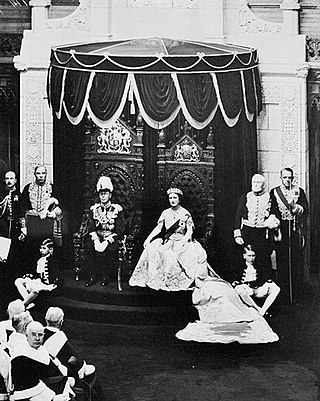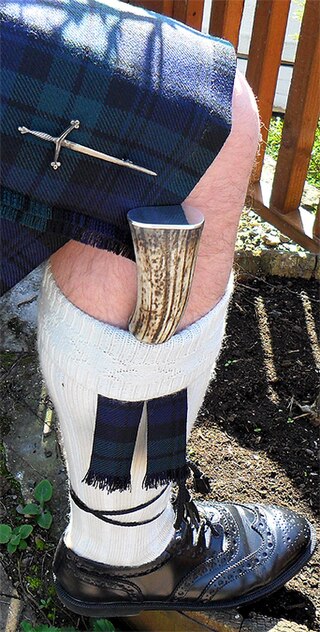
The Act of Settlement is an Act of the Parliament of England that settled the succession to the English and Irish crowns to only Protestants, which passed in 1701. More specifically, anyone who became a Roman Catholic, or who married one, became disqualified to inherit the throne. This had the effect of deposing the remaining descendants of Charles I, other than his Protestant granddaughter Anne, as the next Protestant in line to the throne was Sophia of Hanover. Born into the House of Wittelsbach, she was a granddaughter of James VI and I from his most junior surviving line, with the crowns descending only to her non-Catholic heirs. Sophia died shortly before the death of Queen Anne, and Sophia's son succeeded to the throne as King George I, starting the Hanoverian dynasty in Britain.

The Parliament of the United Kingdom is the supreme legislative body of the United Kingdom, and may also legislate for the Crown Dependencies and the British Overseas Territories. It meets at the Palace of Westminster, London. It possesses legislative supremacy and thereby ultimate power over all other political bodies in the UK and the overseas territories. Parliament is bicameral but has three parts, consisting of the sovereign (King-in-Parliament), the House of Lords, and the House of Commons. In theory, power is officially vested in the King-in-Parliament. However, the Crown normally acts on the advice of the prime minister, and the powers of the House of Lords are limited to only delaying legislation; thus power is de facto vested in the House of Commons.

The United Kingdom has four legal systems, each of which derives from a particular geographical area for a variety of historical reasons: English and Welsh law, Scots law, Northern Ireland law, and, since 2007, purely Welsh law as a result of Welsh devolution, with further calls for a Welsh justice system.

Royal assent is the method by which a monarch formally approves an act of the legislature, either directly or through an official acting on the monarch's behalf. In some jurisdictions, royal assent is equivalent to promulgation, while in others that is a separate step. Under a modern constitutional monarchy, royal assent is considered little more than a formality. Even in nations such as the United Kingdom, Norway, the Netherlands, Liechtenstein and Monaco which still, in theory, permit their monarch to withhold assent to laws, the monarch almost never does so, except in a dire political emergency or on advice of government. While the power to veto by withholding royal assent was once exercised often by European monarchs, such an occurrence has been very rare since the eighteenth century.

The Crown Jewels of the United Kingdom, originally the Crown Jewels of England, are a collection of royal ceremonial objects kept in the Tower of London, which include the coronation regalia and vestments worn by British monarchs.
The King-in-Parliament, sometimes referred neutrally as the Crown-in-Parliament, is a technical term of constitutional law in the Commonwealth realms that refers to the Crown in its legislative role, acting with the advice and consent of the parliament. Bills passed by the houses are sent to the sovereign, or governor-general, lieutenant-governor, or governor as his representative, for Royal Assent, which, once granted, makes the bill into law; these primary acts of legislation are known as acts of parliament. An act may also provide for secondary legislation, which can be made by the Crown, subject to the simple approval, or the lack of disapproval, of parliament.

Succession to the British throne is determined by descent, sex, legitimacy, and religion. Under common law, the Crown is inherited by a sovereign's children or by a childless sovereign's nearest collateral line. The Bill of Rights 1689 and the Act of Settlement 1701 restrict succession to the throne to the legitimate Protestant descendants of Sophia of Hanover who are in "communion with the Church of England". Spouses of Catholics were disqualified from 1689 until the law was amended in 2015. Protestant descendants of those excluded for being Roman Catholics are eligible.

The sgian-dubh – also anglicized as skene-dhu – is a small, single-edged knife worn as part of traditional Scottish Highland dress along with the kilt. Originally used for eating and preparing fruit, meat, and cutting bread and cheese, as well as serving for other more general day-to-day uses such as cutting material and protection, it is now worn as part of traditional Scottish dress tucked into the top of the kilt hose with only the upper portion of the hilt visible. The sgian-dubh is normally worn on the same side as the dominant hand.
The Regency Acts are Acts of the Parliament of the United Kingdom passed at various times, to provide a regent in the event of the reigning monarch being incapacitated or a minor. Prior to 1937, Regency Acts were passed only when necessary to deal with a specific situation. In 1937, the Regency Act 1937 made general provision for a regent, and established the office of Counsellor of State, a number of whom would act on the monarch's behalf when the monarch was temporarily absent from the realm or experiencing an illness that did not amount to legal incapacity. This Act, as modified by the Regency Acts of 1943 and 1953, forms the main law relating to regency in the United Kingdom today.

The Theft Act 1607 is an Act of the Parliament of Scotland.

The inter regalia are the rights falling to the Crown in Scots Property law. The term derives from Latin inter (among) and regalia.

Scots property law governs the rules relating to property found in the legal jurisdiction of Scotland. As a hybrid legal system with both common law and civil law heritage, Scots property law is similar, but not identical, to property law in South Africa and the American state of Louisiana.
The royal prerogative is a body of customary authority, privilege, and immunity recognized in common law and, sometimes, in civil law jurisdictions possessing a monarchy as belonging to the sovereign and which have become widely vested in the government. It is the means by which some of the executive powers of government, possessed by and vested in a monarch with regard to the process of governance of the state, are carried out.

An Act of Adjournal is secondary legislation made by the High Court of Justiciary, the supreme criminal court of Scotland, to regulate the proceedings of Scottish courts hearing criminal matters. Now primarily derived from the Criminal Procedure (Scotland) Act 1995, the original power to create Acts of Adjournal is derived from an Act of the Parliament of Scotland of 1672. Before promulgation, Acts of Adjournal are reviewed and may be commented upon by the Criminal Courts Rules Council.
Sir Bevis Bulmer (1536–1615) was an English mining engineer during the reigns of Elizabeth I and James I. He has been called "one of the great speculators of that era". Many of the events in his career were recorded by Stephen Atkinson in The Discoveries and Historie of the Gold Mynes in Scotland, compiled in part from a lost manuscript by Bulmer entitled Bulmer's Skill.

The Succession to the Crown Act 2015(Cth) is an Act of the Parliament of the Commonwealth of Australia, which was enacted at the request of all six Australian states as required by the Australian Constitution. The Australian acts were the final part of the Perth Agreement's legislative program agreed by the prime ministers of the Commonwealth realms to modernise the succession to the crowns of the sixteen Commonwealth realms, while continuing to have in common the same monarch and royal line of succession, as was the case at the time of the Statute of Westminster 1931.

Occupatio or occupation is a method of original acquisition of property in Scots law. It derives from the Roman law concept of the same name. Occupatio allows an occupier of an object (res) with the intention to own the property to become the owner. As most property in Scotland is owned, and with the caduciary right that all ownerless property falls to the Crown, its application is uncommon. Nevertheless, it remains a valid method of acquiring ownership in Scots law.

Hilderston or Hilderstone in West Lothian, Scotland, was the site of the discovery of a vein of silver in 1606 and a mining operation that attracted international interest. King James used rumours of a silver bonanza to leverage a loan in the City of London. He took over the mine works, an act sometimes regarded as an example of nationalization. The enterprise may have inspired a satirical stage play. On 8 May 1608 work commenced under royal supervision. Miners from Cornwall and Germany were employed in the works.
Gold has been mined in Scotland for centuries. There was a short-lived gold rush in 1852 at Auchtermuchty and Kinnesswood, and another in 1869 at Baile An Or on the Kildonan burn in Helmsdale in Sutherland. There have been several attempts to run commercial mines. In the Lowther Hills, Leadhills, and Wanlockhead areas gold prospecting and the extraction of lead metal went hand in hand. From 1424, under the Royal Mines Act, until 1592, gold and silver mined in Scotland were deemed to belong to the crown. The 1592 Act vested rights for gold, silver, lead, copper, tin, and other minerals in the king's feudal tenants or other leaseholders, who would pay 10% of any profit to the crown. The Act also established a Master of Metals as a crown officer, a position held from June 1592 by Lord Menmuir. followed by Thomas Hamilton of Monkland in March 1607.











